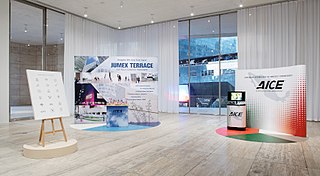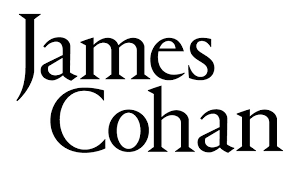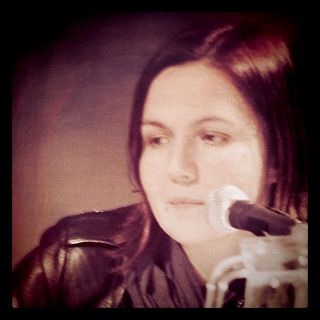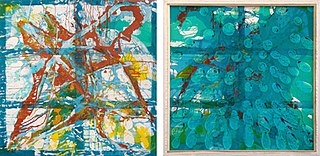Related Research Articles

Amy Sillman is a New York-based visual artist, known for process-based paintings that move between abstraction and figuration, and engage nontraditional media including animation, zines and installation. Her work draws upon art historical tropes, particularly postwar American gestural painting, as both influences and foils; she engages feminist critiques of the discourses of mastery, genius and power in order to introduce qualities such as humor, awkwardness, self-deprecation, affect and doubt into her practice. Profiles in The New York Times, ARTnews, Frieze, and Interview, characterize Sillman as championing "the relevance of painting" and "a reinvigorated mode of abstraction reclaiming the potency of active brushwork and visible gestures." Critic Phyllis Tuchman described Sillman as "an inventive abstractionist" whose "messy, multivalent, lively" art "reframes long-held notions regarding the look and emotional character of abstraction."

Carol Bove is an American artist based in New York City. She lives and works in Brooklyn.

Michael Smith is an American artist known for his performance, video and installation works. He emerged in the mid-1970s at a time when performance and narrative-based art was beginning to claim space in contemporary art. Included among the Pictures Generation artists, he also appropriated pop culture, using television conventions rather than tropes from static media. Since 1979, much of Smith's work has centered on an Everyman character, "Mike," that he has portrayed in various domestic, entrepreneurial and artistic endeavors. Writers have described his videos and immersive installations as "poker-faced parodies" that sit on the edge between art and entertainment, examining ideas, cultural shifts and absurdities involving the American dream, consumerism, the art world, and aging. Village Voice critic Jerry Saltz called Smith "a consummate explorer of the land of the loser … limning a fine line between reality and satire [in] a genre sometimes called installation verité."

James Cohan is a contemporary art gallery co-founded by James and Jane Cohan in 1999, which operates spaces in the Manhattan, New York neighborhoods of Tribeca and the Lower East Side.

Roberta Smith is co-chief art critic of The New York Times and a lecturer on contemporary art. She is the first woman to hold that position at the Times.
Violet Hopkins is an American painter. She holds a BFA from the University of Texas at Austin, and an MFA from the California Institute of the Arts, Valencia. Hopkins work often draws inspiration from found images of the natural and scientific world, using ink, pencil and paint to transform them into color-rich, dynamic scenes that incorporate both abstract and figurative elements.

Hany Armanious is an Egyptian born, Australian artist who lives and works in Sydney. Armanious produces installations and sculptural forms, as well as paintings and drawings.

Olga Chernysheva is a contemporary artist who lives and works in Moscow. Her work spans film, photography, drawing and object-based mediums, where she draws on quotidian moments and marginal spaces from everyday life as a way of exploring the increasing fragmentation of master narratives in contemporary Russian culture.
Ester Partegàs is a Spanish contemporary artist and educator. She lives and works in Brooklyn, New York.
Simone Gilges was a German contemporary artist who was a founding member of Honey-Suckle Company, and the publisher of "Freier", a magazine for the mental state. She lived and worked in Berlin.

Jimmy Baker is an associate professor in the Studio Department at the Art Academy of Cincinnati. He has exhibited work in New York, Los Angeles, Paris, London, Basel, Miami, Chicago, Dallas, and other American cities. His work has been featured in many publications, private collections, as well as permanent collections at the Crystal Bridges Museum of American Art, Zabludowicz Art Trust London, Taschen Foundation Berlin, Cincinnati Art Museum, Columbus Museum of Art, JP Morgan Chase Collection, and Progressive Insurance Collection.

Petra Cortright is an American artist working in video, painting, and digital media.

Dona Nelson is an American painter, best known for immersive, gestural, primarily abstract works employing unorthodox materials, processes and formats to disrupt conventional notions of painting and viewership. A 2014 New Yorker review observed, "Nelson gives notice that she will do anything, short of burning down her house to bully painting into freshly spluttering eloquence." Since 2002, long before it became a more common practice, Nelson has produced free-standing, double-sided paintings that create a more complex, conscious viewing experience. According to New York Times critic Roberta Smith, Nelson has dodged the burden of a "superficially consistent style," sustained by "an adventuresome emphasis on materials" and an athletic approach to process that builds on the work of Jackson Pollock. Writers in Art in America and Artforum credit her experimentation with influencing a younger generation of painters exploring unconventional techniques with renewed interest. Discussing one of Nelson's visceral, process-driven works, curator Klaus Kertess wrote, the paint-soaked "muslin is at once the tool, the medium, and the made."
Sara Cwynar is a contemporary artist who works with photography, collage, installation and book-making. Cwynar was born in Vancouver, Canada in 1985 and currently lives and works in Brooklyn, New York. Cwynar's work presents a marriage of old and new forms that are intended to challenge the way that people encounter visual and material culture in everyday life.
Michele Abeles is an American visual artist and photographer.
Rachel Foullon is an American artist and curator. Foullon has exhibited her works in galleries and museums nationally and internationally in addition to organizing and curating multiple exhibitions across the United States. She is also the Director of Operations at Monkeypaw Productions.
Bortolami is a contemporary art gallery founded in 2005 by Stefania Bortolami and Amalia Dayan.

Joanna Pousette-Dart is an American abstract artist, based in New York City. She is best known for her distinctive shaped-canvas paintings, which typically consist of two or three stacked, curved-edge planes whose arrangements—from slightly precarious to nested—convey a sense of momentary balance with the potential to rock, tilt or slip. She overlays the planes with meandering, variable arabesque lines that delineate interior shapes and contours, often echoing the curves of the supports. Her work draws on diverse inspirations, including the landscapes of the American Southwest, Islamic, Mozarabic and Catalan art, Chinese landscape painting and calligraphy, and Mayan art, as well as early and mid-20th-century modernism. Critic John Yau writes that her shaped canvasses explore "the meeting place between abstraction and landscape, quietly expanding on the work of predecessors", through a combination of personal geometry and linear structure that creates "a sense of constant and latent movement."

Harriet Korman is an American abstract painter based in New York City, who first gained attention in the early 1970s. She is known for work that embraces improvisation and experimentation within a framework of self-imposed limitations that include simplicity of means, purity of color, and a strict rejection of allusion, illusion, naturalistic light and space, or other translations of reality. Writer John Yau describes Korman as "a pure abstract artist, one who doesn’t rely on a visual hook, cultural association, or anything that smacks of essentialization or the spiritual," a position he suggests few post-Warhol painters have taken. While Korman's work may suggest early twentieth-century abstraction, critics such as Roberta Smith locate its roots among a cohort of early-1970s women artists who sought to reinvent painting using strategies from Process Art, then most associated with sculpture, installation art and performance. Since the 1990s, critics and curators have championed this early work as unjustifiably neglected by a male-dominated 1970s art market and deserving of rediscovery.

David Lewis was a contemporary art gallery in New York founded by art historian David Lewis in 2013. The gallery was known for representation and championing prominent international artists such as Barbara Bloom and the estates of Thornton Dial, John Boskovich and Mary Beth Edelson.
References
- ↑ Rachel, T. Cole (July 1, 2008). "Foxy Production Art Gallery: New York, NY (Michael Gillespie)(Interview)". The Fader. Archived from the original on November 3, 2012. Retrieved March 10, 2010.
- ↑ Rule, Dan (January 16, 2013). "Dispatch: John Thomson of Foxy Production". Broadsheet. Retrieved April 21, 2019.
- ↑ "Foxy Production | Art in Chelsea, New York". Time Out New York. April 7, 2010. Retrieved April 21, 2019.
- ↑ Cotter, Holland (June 27, 2003). "ART IN REVIEW; 'Blinky'". The New York Times. Retrieved July 1, 2014.
- ↑ "Galleries have Tunnel vision for Chelsea Terminal spaces". The Real Estate Weekly. Hagedorn Publication. March 29, 2006. Archived from the original on March 8, 2007. Retrieved March 10, 2010.
- ↑ Ghorashi, Hannah (October 16, 2015). "Foxy Production Is Moving to Chinatown". ARTnews. Retrieved April 21, 2019.
- ↑ Sherman, Sam (February 14, 2014). "Critic's Picks: Hany Armanious". Artforum. Archived from the original on July 14, 2014. Retrieved July 1, 2014.
- ↑ "The Artist Who Scours Instagram and the Internet". The New Yorker. March 22, 2019. Retrieved August 13, 2020.
- ↑ "Goulding the Lolly". Art in America. July 21, 2016. Retrieved August 13, 2020.
- ↑ Wilson, Michael (November 2012). "Michael Wilson on Michael Bell-Smith". Artforum. Retrieved April 21, 2019.
- ↑ McLean-Ferris, Laura (January 2015). "Laura McLean-Ferris on Michael Bell-Smith". Artforum. Retrieved April 21, 2019.
- ↑ Misiano, Viktor (March 2010). "MOTION STUDIES: THE ART OF OLGA CHERNYSHEVA". www.artforum.com. Retrieved April 21, 2019.
- ↑ Davidson, Reilly (May 7, 2020). "Srijon Chowdhury". Artforum. Retrieved August 13, 2020.
- ↑ Wyma, Chloe. "Petra Cortright: 'Offline: The Inscrutable Cheeriness of Petra Cortright'". Blouinartinfo. Retrieved April 17, 2015.
- ↑ Smith, Roberta (April 24, 2014). "Sara Cwynar: 'Flat Death'". The New York Times. Retrieved July 1, 2014.
- ↑ Wilson, Siona. "Simone Gilges: 'Simone Gilges'" (PDF). Art Review 59. Retrieved April 17, 2015.
- ↑ "Simone Gilges". The New Yorker. Retrieved April 21, 2019.
- ↑ "Simone Gilges". ArtSlant. Retrieved April 21, 2019.
- ↑ Peri, Peter (March 2013). "Future Greats". Art Review. Retrieved July 1, 2014.
- ↑ Sholis, Brian (October 2009). "Brian Sholis on Violet Hopkins". Artforum. Retrieved April 21, 2019.
- ↑ Heinrich, Will (May 21, 2014). "Stephen Lichty at Foxy Production". GalleristNY. Archived from the original on May 22, 2014. Retrieved July 1, 2014.
- ↑ Schwabsky, Barry (November 2019). "Cindy Ji Hye Kim". Artforum. Retrieved August 13, 2020.
- ↑ Carsel, Casey (May 8, 2020). "Cindy Ji Hye Kim: Drawing the Unseen". Ocula. Retrieved August 13, 2020.
- ↑ Davis, Ben (October 27, 2010). "Transcendent Trash". Artnet. Retrieved July 1, 2014.
- ↑ Smith, Roberta (June 19, 2014). "Sterling Ruby: 'Sunrise Sunset'". The New York Times. Retrieved July 1, 2014.
- ↑ Small, Rachel (April 8, 2015). "Travess Smalley: 'Modes of Perception'". Interview Magazine. Retrieved April 17, 2015.
- ↑ "New Galleries: Foxy Production, Société, Et al". artlosangelesfair.com. Retrieved April 21, 2019.
- ↑ Carlin, T.J. (May 2011). "Highways Connect and Divide" (PDF). ArtReview. Retrieved July 1, 2014.
- ↑ "Highways Connect and Divide". Rhizome. March 8, 2011. Retrieved April 21, 2019.
- ↑ Cotter, Holland (July 7, 2011). "'The Phantasm'". The New York Times. Retrieved July 1, 2014.
- ↑ McClemont, Doug (December 13, 2011). "NYC Top 10 By DOUG MCCLEMONT". Saatchi Online Magazine. Archived from the original on July 14, 2014. Retrieved July 1, 2014.
- ↑ Smith, Roberta (October 2, 2009). "Art in Review: 'Abstract Abstract'". The New York Times. Retrieved July 1, 2014.
- ↑ Davis, Ben (February 14, 2007). "Net Worth". Artnet. Retrieved July 1, 2014.
- ↑ Zhong, Taea (March 19, 2014). "Lauren Cornell: Crusading Curator". W Magazine. Archived from the original on July 13, 2014. Retrieved July 1, 2014.
- ↑ Smith, Roberta (August 6, 2004). "The Infinite Fill Group Show". The New York Times. Retrieved July 1, 2014.